Hell Hole Reservoir
Hell Hole reservoir is an artificial, crescent-shaped lake in the Sierra Nevada mountain range 10 miles (16 km) west of Lake Tahoe in California, United States. The lake is about 3.5 miles (5.6 km) long when at full capacity.
| Hell Hole Reservoir | |
|---|---|
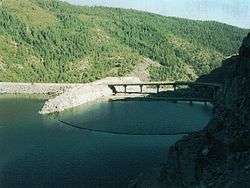 | |
| Location | Placer County, California |
| Coordinates | 39.08011°N 120.39230°W |
| Type | Reservoir |
| Basin countries | United States |
| Water volume | 208,400 acre⋅ft (257,100,000 m3) |
| Surface elevation | 4,630 ft (1,411 m) |
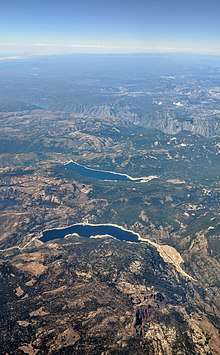
The lake was created in 1966 with the completion of Lower Hell Hole Dam[1] across the Rubicon River, which is a major tributary of the Middle Fork of the American River. Hell Hole is named for a deep canyon which is now under the waters of the lake.
How the canyon came to be named Hell Hole is a combination of folklore and speculation. An early author, George Wharton James (1858–1923), visited the canyon in 1913.[2] He attributed the name to an unidentified miner seeking riches during the Squaw Valley mining excitement of 1862. It was "a hell of hole to get out of," James wrote, but admitted his source for the place name was more speculative than the anonymous miner's chances for riches at Squaw Valley.
James' guide for the 1913 camping expedition to Hell Hole was Bob Watson, a well-known camping guide who operated in the Lake Tahoe Region from the 1880s into the first decades of the 20th century. Watson may have been the source of the story who sought to entertain and edify his paying clients with tales of local history. James attributed much of the local lore to Watson.
The United States Board on Geographic Names attributes the first use of the name "Hell Hole" to a United States Geological Survey map of 1894. The board was created in 1890, so previous uses of the name on federal government maps are possible.
James reported finding a natural lake near the Hell Hole chasm known as Bear Lake, which would have been drowned by the reservoir. He also described Hell Hole in terms that belies the colorful name: "Hell Hole? Then give me more of it," he wrote. The author reported his pleasure of the canyon was derived from its rugged nature that precluded human exploitation: Logging, mining, water development and road building, evident in other portions of the Lake Tahoe region. It was "a paradise of delightful surprises," he wrote.
Current conditions
Lower Hell Hole Dam (its official name) is operated by the Placer County Water Agency. The agency controls two dams in the Eldorado National Forest and Tahoe National Forest. The water agency gained its power from financing approved by Placer County voters in 1961.
Proposals for the dam date to 1958.[3] In 1964 the first Hell Hole dam was partially complete.[4] The dam collapsed on December 23, 1964.[5] A new dam was completed in 1966.[6] Placer County sought drinking water supplies to fuel growth of its communities in the Sacramento Valley. The gold-rush-era town of Auburn is in Placer County as is the suburban community of Roseville. The agency also sought to generate hydroelectric power to finance its ability to deliver the water to users.
Recreational uses
Today, the lake offers modern facilities to aid in waterborne recreation. The remoteness of the lake limits the number of visitors, so the lake is seldom crowded even during the height of the summer season. Most boating activity is limited to small powered fishing skiffs, canoes and kayaks. Afternoon high winds can make boating precarious.
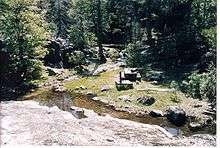
The lake is known by its three components: Lower Hell Hole, the Narrows and Upper Hell Hole. The lake is accessible by motor vehicle only at Lower Hell Hole, where a paved launch facility and forest service ranger station are located. The Hell Hole campground is also located there.
The campground features a view of the polished granite lakeshore but is not located directly on the shore of the lake because of the steep grade. The campground features a parking area but the 10 campsites are walk-in only. Many visitors use Big Meadows campground about one mile (1.6 km) away, which has 54 drive-in campsites suitable for recreational vehicles.
A second forest service campground is maintained at Upper Hell Hole and is known by that name. It can be reached by boat or a 3.5-mile (5.6 km) hiking trail that is reached by crossing the breakwater of the dam and hiking on a trail that flanks the lake but is several hundred feet above the water.
Upper Hell Hole campground is said to have 15 campsites and two pit toilets, but does not have trash service or other amenities. A camping fee is not charged. The campground is arranged on three tiers of elevation. Steps are cut into the granite rock to connect the levels. During the spring and early summer snowmelt, several of the campsites feature creeks and waterfalls nearby. Other campsites there are sheltered by giant granite boulders. Camping is also permitted wherever the rugged shoreline will permit boat landing.
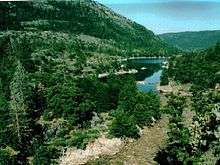
The lake's principal inflows are from the Rubicon River and Five Lakes Creek, formerly a tributary of the Rubicon. Lake water has drowned the historical confluence of the two water courses. The Rubicon River was once known as the south fork of the middle fork of the American River. The Rubicon River's entry into the lake is via a cataract where the river has eroded through the elevated granite block.
The lake also features many small granitic islands that expand and contract with the level of the lake. Hell Hole typically has its highest level of water in May and lowers gradually through the summer and fall. The forest service maintains visitor services from May 15 through September 15. The lake is accessible until snow makes roads to the area impassable.
In 1984, the federally protected Granite Chief Wilderness was created by the United States Congress after a long advocacy campaign by the Sierra Club, a conservation organization.
Upper Hell Hole forms the western border of the Granite Chief Wilderness. A small buffer zone between the lake shore and the wilderness prevents accidental intrusion into the wilderness. The juxtaposition of the lake and wilderness presents the opportunity for rustic boat/backpacking adventures through the rugged and scenic 25,680 acres (103.9 km2) of wilderness. Like the lake itself, the wilderness is lightly used on the western border. Hell Hole Trail enters the wilderness from near the lake but is difficult to locate. Granite Chief Wilderness is managed by the Tahoe National Forest, while visitor facilities at Hell Hole are exclusively managed by El Dorado National Forest (Georgetown district).
The Truckee and American River (formerly Foresthill) ranger districts of the Tahoe National Forest advise caution at Granite Chief: "Topographic maps and skills to use them are highly recommended in the wilderness because of the minimal level in signing and remoteness of the area." Wilderness permits are not required to enter the Granite Chief Wilderness. Campfire permits are always required.[7]
The California Office of Environmental Health Hazard Assessment (OEHHA) has developed a safe eating advisory[8] for Hell Hole Reservoir based on levels of mercury found in species of fish caught there.[9]
Hydrology
The construction of the present Hell Hole Dam also changed the course of the Rubicon River.
The pre-dam river channel wended its way several miles to its confluence with the Middle Fork of the American River near Ralston Afterbay. Now, In addition to releases from Hell Hole down the pre-dam path, water is diverted through a pipeline to Middle Fork Powerhouse (AKA Stephenson Powerhouse) where it flows into Interbay Reservoir. From here, in addition to releases down the Middle Fork American River, the water is diverted into a tunnel to Ralston Powerhouse and into Ralston Afterbay, where it joins water from the pre-dam path. Oxbow Powerhouse and Oxbow control dam there releases water into the middle fork of the American River just below the spot of the historical confluence.
Water for hydroelectric generation is also shuttled into Hell Hole from French Meadows Reservoir which impounds the Middle Fork of the American River. The water travels through a tunnel to a powerhouse located on the north side of Hell Hole. French Meadows, at 5,200 elevation, is higher than the 4,700-foot (1,400 m) elevation at Hell Hole. The
powerhouse at Hell Hole is actually known by the name, French Meadows powerhouse.[10]
The traditional channel of the Rubicon River still maintains water flow from the spillway at Hell Hole Dam and from tributaries of the Rubicon below the dam, such as Gerle Creek (pronounced girly).
The Placer County Water Agency does not take water directly from Hell Hole or the other dam but instead claims rights to the water as it is shipped through the American River System and ends up at Folsom Lake near Sacramento. Folsom dam was originally constructed for the purposes of flood control. The Placer water agency's dams and Ralston are presently known as the Middle Fork Project.
Historical usage
Hell Hole canyon and nearby vicinities initially escaped man-made exploitation during the latter half of the 19th century, but events that occurred then allowed eventual exploitation of Hell Hole during the 1960s.
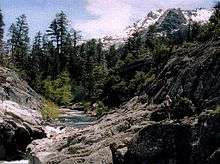
The gold rush of 1849 on the South Fork of the American River resulted in establishment of Sierra foothill towns of Auburn, Placerville, Nevada City and Georgetown. The gold rush did not intrude into the higher elevations of the Sierra Nevada range, but the water and timber needs of these towns did intrude into the upper elevations. In one case in 1873 the privately owned, California Water Company[11] employed a scheme to dam Loon Lake to the south of Hell Hole and then sluice the water closer to Georgetown where it could be used by residents and farmers.[12]
Somewhat later, in 1862, the residents of Placer County (Auburn, Foresthill) came upon a scheme to build a road from the Foresthill divide to Squaw Valley with the intent of luring immigrant trains away from Nevada City and into Placerville and neighboring vicinities. George Wharton James, the author, described the road as an ill-fated enterprise: "The grade is frightful. For an hour or more, we go slowly up it stopping every few yards or so to give our horses breath," James wrote of a ride on the old road a half century after it was built. "It is hard enough for horses to go up this grade but to pull heavily-ladened (sic) wagons - it seems impossible, " he concluded. Later attempts to improve this road or forge other wagon roads were not successful.
The Comstock Lode silver rush in the 1860s in Nevada Territory also encouraged the attempt of the gold-rush foothillers to find pathways over the mountains to the riches of the Comstock and the more local Squaw Valley silver excitement.
The roads then brought timber claimants and homesteaders, called locators, who were able to claim public lands. The old homesteads and timber claims were bought by private water companies or hoteliers who sought visitors to the "healthful" mineral springs after much of the timber was depleted by the mid-1880s.
Railroads brought the tourists. Tourists could reach Truckee, California by rail from either San Francisco or Ogden, Utah by the end of the 19th century. The Lake Tahoe Railway and Transportation Company brought them to the lake. One particular resort established east of Hell Hole has a significant relationship to the canyon. Deer Park, just south of Squaw Valley (now a ski area and home to the 1960 Winter Olympics) was a tourist hotel which had a rustic hideaway camp at Five Lakes now in Granite Chief Wilderness. James described the Five Lakes resort as a 160-acre (0.65 km2) timber claim in which the timber had never been cut but in which cabins had been built and rowboats kept in hand for fishing upon the five small lakes.
The Five Lakes are the headwaters of Five Lakes Creek which led James on his 1913 horseback descent into Hell Hole in the company of Bob Watson, the guide. The pair camped at Hell Hole, then ascended the Rubicon River to Rockbound Lake, where they camped again. Rockbound Lake is now in the Desolation Wilderness and is near the headwaters of the Rubicon River. The Sacramento Municipal Utility District controls a dam within the Desolation Wilderness: Rubicon Reservoir. Desolation Wilderness was created in 1969.
Recent history
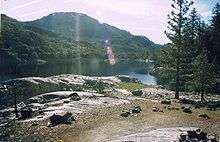
Placer County's 1961 bond approval allowed its water agency to seek out water supplies that were not already claimed by others. Loon Lake, south of Hell Hole, was already prescripted, but the rugged, untouched Hell Hole was not. In 1934, the State of California took steps to claim any unclaimed water rights along the American River's three forks. In 1962 the rights to the Rubicon River water were conveyed to Placer County.[13]
The Hell Hole dam, a rock-fill-type dam, was completed across the Rubicon River in December 1964. As the reservoir began filling the dam sprung a leak during a flood event and failed completely the next day. The resulting flood washed down the Middle Fork of the American River and washed away the Greenwood Bridge near Auburn.[14]
The Placer County Water Agency began a new dam which was completed two years later and has now stood for 42 years.[15]
Hell Hole Dam was partially completed at the time of extremely heavy storms in December 1964. The downstream rockfill portion was up ~220' above the river bottom, but the impervious core and adjacent zones were only up ~35'. Debris from extreme storm runoff upstream of the dam blocked the diversion outlet, and water rapidly accumulated behind the partially constructed dam. As the water came up it was seeping through the rockfill, and when it crested, the entire mass collapsed in a matter of minutes. A surge went down the canyon, washing out two older suspension bridges below the Long Canyon influx and at the Spanish Dry Diggings crossing near Greenwood. It then washed out the State Highway 49 bridge over the American River just below Auburn.[16] Folsom Dam reservoir absorbed the surge below that point.
See also
- List of dams and reservoirs in California
- List of largest reservoirs of California
- American River (California) topics
References
- Brass plaque installed at dam breakwater: "Placer County Water Agency; Middle Fork American River Development; Hell Hole Reservoir and Dam -1966. Acre feet - 207,590. Height 410 feet (120 m). Area 1,253 acres (5.07 km2)."
- James, George Wharton The Lake of the Sky, J.F. Tapley Co, New York,1915 Ch.15-16
- "The hearing of the California Board of Water Rights" (PDF). Archived from the original (PDF) on 2007-07-15. Retrieved 2008-03-08.
- Fisher-Smith, Jordan Nature noir : a park ranger's patrol in the Sierra Houghton Mifflin, Boston Mass., 2005.
- "Hell Hole Dam collapse 50 years ago today continues to teach". Auburn Journal. Retrieved 2019-02-25.
- "California planning US$1.8 million Hell Hole Dam core raise project". www.hydroworld.com. Retrieved 2019-02-25.
- U.S. Forest Service, Tahoe National Forest, Truckee and Foresthill Ranger Districts, Granite Chief Wilderness information packet.
- Pham, Huyen Tran (2016-05-12). "Hell Hole Reservoir". OEHHA. Retrieved 2018-06-13.
- Placer County Water Agency, Map 1, Archaeological Survey, 2006, 2007
- Sources differ on who dammed Loon Lake. Mike Brattland of Gerle Creek.com cites the California Water Company, while George Wharton James (cited above) wrote the dam was in the hands of the Reno Water and Electric Power Company the two citations are 40 years apart and both could be correct.
- "Gerle creek history". Archived from the original on 2008-07-04. Retrieved 2008-03-08.
- "The California Water Rights Board hearings" (PDF). Archived from the original (PDF) on 2007-07-15. Retrieved 2008-03-08.
- "The UC Davis School of Engineering with photos of dam failure". Archived from the original on 2008-03-19. Retrieved 2008-03-08.
- [The author, User:Vabulf] worked for McCreary-Koretsky Engrs on the MFAR Project-between June 1964 and December of 1965 and before that worked for Ets-Hokins & Galvin on the Brushy Springs(Middle Fork) Powerhouse & Penstock.
- "1964 Highway 49 Bridge Rubble Remains A Cleanup Quandary". AmericanRiverWildlife.com. WordPress. Retrieved 30 September 2014.
| Wikimedia Commons has media related to Hell Hole Reservoir. |